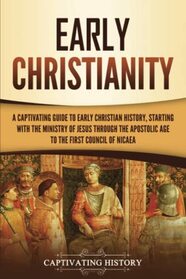Between the ascension of Christ and the Church in the Middle Ages, there is a fuzzy area of Christianity when many of the wrinkles were ironed out about what to believe. Captivating History uses the Bible and extra-biblical references to flesh out the early years of Christianity. It must have been a confusing time. With Paul and the 12 Apostles (minus Judas Iscariot and plus Mattias), each man's story must have varied over time. As Christianity spread over the known world, different sects and beliefs emerged.
Then, there were the Arian Christians (who did not believe that Jesus was coeternal with the Father) and the Gnostics (who wanted to ignore the Old Testament of the Bible and denied the physical resurrection of Christ), along with other sects that had to be resolved with the Christian beliefs. One of the things I enjoy about Captivating History is the little nugget of amazing facts they unearth in their books. For example, the word martyr derives from Justin Martyr, an early Church follower who was beheaded. The other nugget I recall is how Israel was renamed Palestine by Hadrian (a Roman emperor).
Another interesting concept of this book is the group of martyrs they chose to explain. I grew up with nuns named Sr. Polycarp and Sr. Perpetua. The young sisters chose those names (Polycarp, Perpetua, and others) because those individual lives meant something to the young novitiates selecting their new names. It is interesting to learn their unique histories all these years later.
Over the years, various councils convened to confirm beliefs that the Church would espouse. They standardized the Bible with the books of the Old and New Testaments. The Council of Nicea in 325 CE was the main Church council covered in this book. Constantine called for the Council to resolve the Arianism controversy and to determine Christ's relationship to God the Father and the Holy Spirit. It was essential to decide on the beliefs of all Christians. Therefore, it included bishops from all over the known world.
Contrary to most Captivating History eBooks, this one has a short appendix for extra reading.
Then, there were the Arian Christians (who did not believe that Jesus was coeternal with the Father) and the Gnostics (who wanted to ignore the Old Testament of the Bible and denied the physical resurrection of Christ), along with other sects that had to be resolved with the Christian beliefs. One of the things I enjoy about Captivating History is the little nugget of amazing facts they unearth in their books. For example, the word martyr derives from Justin Martyr, an early Church follower who was beheaded. The other nugget I recall is how Israel was renamed Palestine by Hadrian (a Roman emperor).
Another interesting concept of this book is the group of martyrs they chose to explain. I grew up with nuns named Sr. Polycarp and Sr. Perpetua. The young sisters chose those names (Polycarp, Perpetua, and others) because those individual lives meant something to the young novitiates selecting their new names. It is interesting to learn their unique histories all these years later.
Over the years, various councils convened to confirm beliefs that the Church would espouse. They standardized the Bible with the books of the Old and New Testaments. The Council of Nicea in 325 CE was the main Church council covered in this book. Constantine called for the Council to resolve the Arianism controversy and to determine Christ's relationship to God the Father and the Holy Spirit. It was essential to decide on the beliefs of all Christians. Therefore, it included bishops from all over the known world.
Contrary to most Captivating History eBooks, this one has a short appendix for extra reading.




